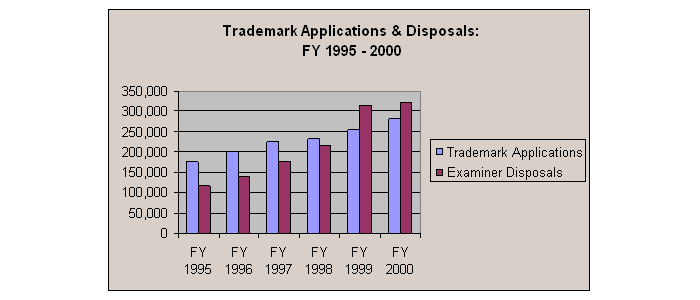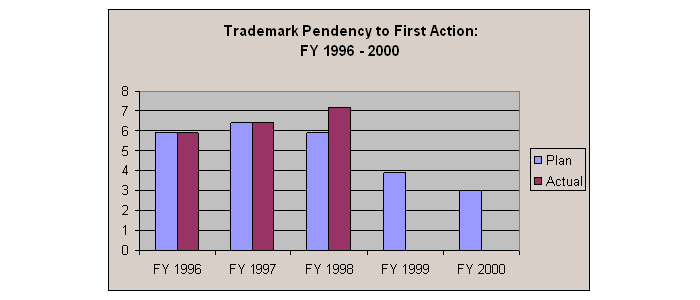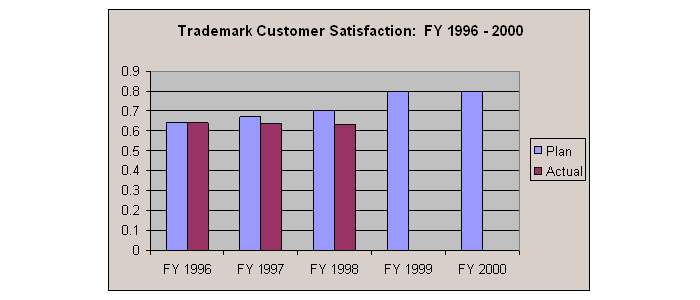Our trademark business continued to show an increase in filings in FY 1998, although at a slower rate from previous years. Our customers filed 196,293 applications for trademarks in 232,384 classes, 3.6 percent more than in FY 1997, and next year we expect to receive up to 10 percent more. Registrations were down nearly 6 percent from FY 1997 to 106,279 classes. Registrations and overall production were lower because there were fewer experienced examiners overall, and the more experienced examiners had to devote much of their time to train and mentor the large number of new examiners hired in FY 1998. With additional staff, we expect FY 1999 registrations to increase by 30 percent to 138,600.
In FY 1999, we will focus on the first action on the application, because this action gives applicants the first indication that their trademarks will be registered, and businesses can use this information to make decisions on commercializing their products. Our goal is to reduce the time to take this first action-first-action pendency-to three months.
First-action pendency rose from 6.4 months in FY 1997 to 7.2 months at the end of FY 1998. Although we do not expect to get first-action pendency down to three months by the end of FY 1999-our original goal-we will continue to work toward that goal. We project first-action pendency to decline to about 5.5 months in FY 1999, a reduction of 24 percent from FY 1998, as the benefits from hiring new trademark attorneys begin to be felt.
Overall customer satisfaction declined slightly, from 64 percent in FY 1996 to 63 percent in FY 1998, short of our FY 1998 goal of 70 percent. 2 Although we did not attain our goal, we did show significant improvement in several important areas, and will focus our efforts in FY 1999 on internal processing issues relating to timeliness, and the handling of delays and mistakes, two problem areas identified in our customer survey.
Legislative changes
The President signed the Trademark Law Treaty Implementation Act on October 30, 1998. The PTO has one year from that date to revise its rules, procedures, workflow processes, and systems to enable full implementation of the treaty.
The Trademark Law Treaty simplifies and harmonizes the requirements for filing applications and maintaining trademark registrations in those countries that are signatories to the treaty. Member countries will be required to discard most legalization requirements, reduce their filing and registration requirements, and accept multi-class applications and service-mark registrations. In contrast, the requirements for post-registration filings will increase.
Our business goals for FY 1999 are to reduce trademark application processing time and to improve the quality of our work through better processing methods and information technology. These goals are consistent with our HIA commitments to reduce trademark processing time to first action, to offer the option of filing applications electronically, to make trademark status information available over the Internet, and to provide work-at-home opportunities to PTO staff.
Our priorities for FY 1999 are to:
- obtain the staff and the resources necessary to reduce pendency;
- implement the provisions of the Trademark Law Treaty (TLT);
- continue the restructuring of our internal systems to enable the full use of computer technology; and
- improve customer satisfaction.
Reducing pendency
To reduce pendency, we are increasing our total staff by 50 percent, and the number of examining attorneys by 67 percent, above FY 1997 levels. In FY 1998, we added 62 attorneys, giving us a total of 287. We plan to have 375 examining attorneys by the end of March 1999. We will realize our full production capacity roughly six months after the last group of examining attorneys is hired. With the addition of these new attorneys, we are also increasing the number of law offices from nine to 15. We created five of the additional offices by December 1998; the sixth will open in January 1999.
We have also launched internal initiatives to find ways of increasing our efficiency. For example, we are examining ways to improve our workflow and file management to avoid delays and duplication of work. We are also acquiring and renovating additional space to accommodate the increase in the number of our law offices and the expansion of our service operations.
Electronic trademark filing and processing
We added several new systems in FY 1998 that move us closer to the PTO's goal of transforming trademark processing into a fully electronic operation by FY 2002.
Trademark electronic application system (TEAS)
We have begun offering electronic filing capabilities to our customers through the trademark electronic application system (TEAS). As part of a pilot project, in November 1997 we started accepting applications for registration filed electronically using the Internet. Participants were required to pay through PTO deposit accounts. Response to the pilot was excellent: in 10 months, the small number of customers participating in the project submitted 251 applications.
In October 1998, we expanded the pilot to make Internet filing available to all customers, and enabled customers to make fee payments by credit card, thus fulfilling one of our commitments to Vice President Gore. In the first ten weeks of expanded operations, we received 2,374 applications electronically. We will introduce additional security features and an improved means of processing fee payments for Internet filings in March 1999, and will add additional trademark forms in FY 2000, after the implementation of the Trademark Law Treaty.
We placed a copy of the trademark application filing form, PrinTEAS, on the PTO Internet site for those applicants who need to include additional materials with their application. The PrinTEAS form guides the user through the application process, providing edits to ensure the information submitted is complete. It can then be printed and mailed to the PTO. We will ultimately make all trademark forms available in TEAS and PrinTEAS formats, and by standardizing them greatly improve our ability to capture data and to process and examine applications.
We still receive the vast majority of applications in paper form, however. To help us move to a fully electronic operation, in April 1998 we piloted a program to create electronic records by scanning and converting them using optical character recognition software. In November 1998, we began using this process on all newly filed applications. We plan to replace manual data entry with scanning for all new applications by October 1999, with all correspondence scanned by February 2000. Although this process has been more labor-intensive than our paper system, we expect that as we gain more experience using the scanning system, and as more applicants switch to electronic filing, the process and quality will improve.
TradeUps
To complement TEAS, which only brings application and payment information into the PTO, we added TradeUps, a PC-based system that electronically codes applications and adds them to our database. In the next few months, we plan to do all data entry throughout the examination process through TradeUps. Future versions of TradeUps will include post-registration and intent-to-use functions, and will enable secure transactions.
We also began enhancing our trademark reporting and monitoring (TRAM) system to accommodate changes that are required under the Trademark Law Treaty. The enhanced TRAM system will provide the basis for a full replacement system, due in 2000. Replacing our proprietary technologies with open systems will allow us to improve the TRAM system's reporting capabilities, integrate intent-to-use processing into the law offices, and support workflow changes. The first phase, planned to occur in stages from June to October 1999, will enhance the pre-examination, examination, and intent-to-use functions with improvements in batch programs, on-line transactions, and reporting. We plan to begin development in 2000 of a trademark information system that, together with TEAS and TradeUps, will replace paper applications and permit full electronic processing of applications and related documents.
Trademark application and registration status information will be made available to the general public over the Internet through the trademark application and registration retrieval system in April 1999. The PTO Internet site will also provide general PTO information, e-mail addresses, and phone numbers for contacting examining attorneys and the Trademark Assistance Center.
Our Work-at-Home project has been in operation as a "reinvention lab" pilot since March 1997, and is scheduled to conclude March 1999. The program gives 18 examining attorneys access to office equipment and to the information databases, permitting them to work from their homes three days a week. An evaluation of the pilot results and a business case will be made prior to the decision to continue or expand the program, which so far appears to be a success.
Improve customer satisfaction
Our customer satisfaction survey results make it clear that the key to resolving complaints is our ability to eliminate problems and to resolve them promptly when they do occur. We are therefore developing performance measures that will assess the quality of our work from the customers' point of view so that we can focus our attention on the sources and causes of their most frequent complaints.
For FY 1999 we will focus on two problem areas identified in the customer survey: internal processing issues relating to timeliness and the handling of delays and mistakes. We are developing a new program, to be launched in 1999, which will match managers with customers to work together to develop a business relationship. Its goal is to obtain data from customers that will help us understand how satisfied or dissatisfied they are with our present level of service, and how we can improve. Further, we have dedicated staff to solving problems and finding the root causes of delays and errors made during application processing. As we focus on these sources of customer satisfaction, we expect to achieve our target of 80 percent in 1999.
Footnotes:
2Customer Satisfaction data is not available for the Patent or Trademark business area for FY 1997.




